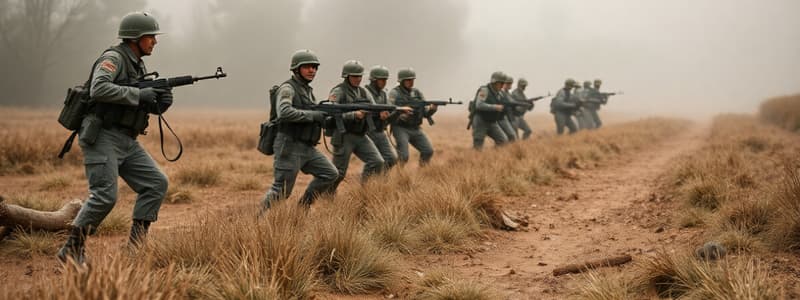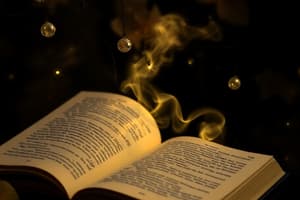Podcast
Questions and Answers
What emotional state does the imagery in the passage primarily convey?
What emotional state does the imagery in the passage primarily convey?
- Joy and happiness
- Dreariness and desperation (correct)
- Excitement and thrill
- Calmness and peace
Which reason is given for soldiers running away from the sound of shells?
Which reason is given for soldiers running away from the sound of shells?
- Desire to reach the safety of trenches (correct)
- Discipline from military orders
- Fear of attack from behind
- The hope of winning a battle
What does the passage imply about the experience of soldiers described as 'Waiting to die'?
What does the passage imply about the experience of soldiers described as 'Waiting to die'?
- They are eagerly anticipating rescue
- They find purpose in their situation
- They are optimistic about their survival
- They experience daily boredom and despair (correct)
What does the phrase 'fists of fingers clutched a blackening wound' signify about the character?
What does the phrase 'fists of fingers clutched a blackening wound' signify about the character?
What is suggested by the statement that 'This was regular and happened all the time'?
What is suggested by the statement that 'This was regular and happened all the time'?
What aspect of the imagery is emphasized in the additional notes?
What aspect of the imagery is emphasized in the additional notes?
What theme does 'All Quiet on the Western Front' adhere to according to the notes?
What theme does 'All Quiet on the Western Front' adhere to according to the notes?
What literary device is being referenced with the example 'our love is doomed like Romeo and Juliet'?
What literary device is being referenced with the example 'our love is doomed like Romeo and Juliet'?
What does the term 'livid' signify in the context of the passage?
What does the term 'livid' signify in the context of the passage?
What is the primary setting of 'The Rear Guard'?
What is the primary setting of 'The Rear Guard'?
How does the character's state of mind appear during the exploration?
How does the character's state of mind appear during the exploration?
What action does the character take when he encounters the motionless figure?
What action does the character take when he encounters the motionless figure?
What does the line 'Dawn's ghost that filtered down a shafted stair' suggest about the atmosphere?
What does the line 'Dawn's ghost that filtered down a shafted stair' suggest about the atmosphere?
What is the implication of the phrase 'unloading hell behind him'?
What is the implication of the phrase 'unloading hell behind him'?
Which of the following best describes the character's interaction with the environment?
Which of the following best describes the character's interaction with the environment?
What does the character hope to find while exploring the tunnel?
What does the character hope to find while exploring the tunnel?
Flashcards
Imagery
Imagery
Descriptive language that appeals to the five senses (sight, sound, smell, taste, touch) to create vivid imagery in the reader's mind.
Allusion
Allusion
A literary device that references another piece of literature, mythology, history, or popular culture.
Metaphor
Metaphor
A literary device that uses figurative language to create a comparison between two unlike things, without using 'like' or 'as'.
Simile
Simile
Signup and view all the flashcards
Mood
Mood
Signup and view all the flashcards
Hyperbole
Hyperbole
Signup and view all the flashcards
Apostrophe
Apostrophe
Signup and view all the flashcards
Alliteration
Alliteration
Signup and view all the flashcards
What emotion does the speaker express when he encounters the dead soldier?
What emotion does the speaker express when he encounters the dead soldier?
Signup and view all the flashcards
Explain the double meaning of "livid face" in the poem?
Explain the double meaning of "livid face" in the poem?
Signup and view all the flashcards
What is the speaker's primary objective throughout the poem?
What is the speaker's primary objective throughout the poem?
Signup and view all the flashcards
How is the speaker's journey through the tunnel described?
How is the speaker's journey through the tunnel described?
Signup and view all the flashcards
What kind of atmosphere is established through the description of the tunnel?
What kind of atmosphere is established through the description of the tunnel?
Signup and view all the flashcards
How does the contrast between the speaker's rage and the soldier's state contribute to the poem's theme?
How does the contrast between the speaker's rage and the soldier's state contribute to the poem's theme?
Signup and view all the flashcards
What are some of the challenges the speaker faces throughout his journey?
What are some of the challenges the speaker faces throughout his journey?
Signup and view all the flashcards
How does the ending of the poem offer a sense of hope for the speaker?
How does the ending of the poem offer a sense of hope for the speaker?
Signup and view all the flashcards
Study Notes
Poem Analysis: The Rear Guard
- Setting: A dark, dangerous tunnel during wartime.
- Character: A soldier, alone and weary.
- Actions: The soldier gropes through the tunnel, encounters a dead soldier, and eventually climbs out of the darkness.
- Tone: The tone is grim and unsettling, reflecting the harsh realities of war. The soldier's experience is one of isolation, dread, and violence.
Imagery and Symbolism
- "Groping along the tunnel, step by step": Physical and emotional struggle in the dark.
- "Unwholesome air": Symbolic of the corruption and decay of war.
- "Mirror smashed, the mattress from a bed": Represents the destruction and violence war brings.
- "Rosy gloom of battle overhead": Contrasting imagery, highlighting the beauty amidst destruction.
- "Humped at his feet, half-hidden by a rug": The dead soldier is hidden and overlooked.
- "Livid face": A face showing both anger and fear, and injury.
- "Fists of fingers clutched a blackening wound": Extreme pain and suffering.
- "Dawn's ghost that filtered down a shafted stair": Symbolic imagery hinting at the glimmer of hope or end of struggle, just before the soldier escapes.
- "Darkness": Represents the terrors of war.
- "Twilight air": The light of approaching dawn or the potential for new beginnings or hope.
Themes
- War's Dehumanizing Effects: Soldiers are treated as mere objects or burdens. The dead soldier represents the casualties of war.
- Fear and Isolation: The haunting and terrifying darkness reflects the emotional state of the soldier.
- Death and Suffering: The encounter with the dead comrade reminds of the constant threat of death.
- Survival: The soldier's arduous journey through the horrors ultimately serves to show the desire for peace in order to survive.
Other Notes
- The poem uses vivid sensory details, creating a powerful sense of unease and immediacy.
- The soldier's actions and emotions powerfully convey the mental and physical tolls of war.
- The poem describes the physical and emotional struggles of a soldier during war.
- The poem connects to other works of literature possibly through symbolism like the reference of "Romeo and Juliet".
Studying That Suits You
Use AI to generate personalized quizzes and flashcards to suit your learning preferences.




